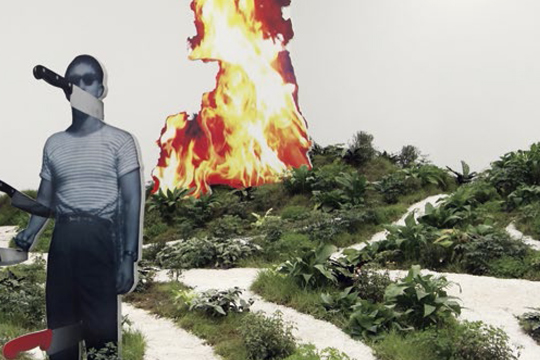XU ZHEN BY MADEIN COMPANY: MOVEMENT FIELD
| July 25, 2013 | Post In LEAP 21

For readers unable to visit this exhibition in person:
The perspective in the photograph to the left appears even stranger in real life. Ignore the stove, clay models, and flames and there is another perspective in a male figure, its body pierced several times with knives, looming gargantuan amongst “mountains.” Gazing beyond him to the “mountaintops,” a towering ginseng root appears dreamlike. If one now instead ignores both the knifed figure and the ginseng tower, then fire can be seen raging amongst clumps of grass (though the grass appears to be unaffected), while the textures of large bizarre clay models and gas stoves clearly surpass their normal state.
These images, appearing together in physical space, make the grass and pebbled paths appear particularly awkward.
Focal perspective has long been relied upon as a means to describe and portray objects; since photography, and particularly since the advent of graphics software, people have used 2D images to view and comprehend physical objects. They have also now become accustomed to the ability to reduce or enlarge the size of an image at will. If we were to take this norm of visual perception, import it back into physical reality, and then photograph it again… we would end up with exactly this image.
This visual landscape is now equally real, and can exist everywhere.
Landscapes in the true sense are very rarely born out of material space. They far more frequently exist within the dissemination of various kinds of media.
For those who were able to visit the exhibition: Try and recall the rough paths of white pebbles between the uneven clumps of grass, the cardboard cut-outs of various sizes, some of giant Bodhisattvas, others of ginseng root, and the pungent smell of earth lingering in the gallery. Remember how it messed with your head.
Now, with those memories fresh in the mind, we return to the image… what do you In many cases, our perception of a work is formed from both its physical appearance and its image representation. This fact presents an extra challenge to the artist: as well as the exhibition itself, the dissemination of the site must be considered. If it can be said that the viewer still possesses the power of choice, the freedom to examine unhindered, then, through the dissemination of images, this perceptual experience is completely reframed under controlled conditions, according to specific aesthetic principles.
By this logic, it no longer seems crucial to place a real object in the gallery. Images can now achieve various visual effects that real objects cannot. The “object” can be enlarged several times over, to fit the space better; it can achieve a clarity that the naked eye itself is unable to; if fire is needed in the space, then its image can instead be used…
This creative rationale originates in MadeIn Company’s 2010 exhibition “Don’t Hang Your Faith on The Wall,” which initiated the series “True Image,” now in its fourth edition. In this series, images are taken out of their original contexts and freely recombined to form new scenarios, thus granting the artist greater freedom to utilize either their form or content.
The paths of white pebbles seen in this exhibition correspondingly refer to the second edition of MadeIn Company’s “Demonstration Series.” On this occasion, the artists have not only brought together various political demonstrations, each with different objectives, but they have also responded to them, installing a set of garden paths which reflect distinctly middle-class tastes, no doubt mocking the formally obsessive tendencies of political movements.
The works in this exhibition are an expression of the artists’ creative attitude and method, advancing simultaneously from creative concerns either already well-trodden or only just set in motion. During the process of mutual comparison and harmonization, their ideas are gradually elucidated, and the requirements of the works are correspondingly heightened. Compared to creative methods imagined up by established value systems, the strategies on display here proceed differently. Each minor adjustment may not be immediately noticeable, but it will always be specific. Over a long period of time these will accumulate, and gradually come together to form a penetrating force.

